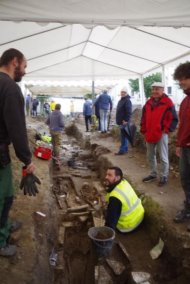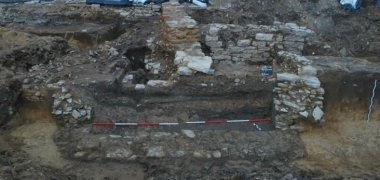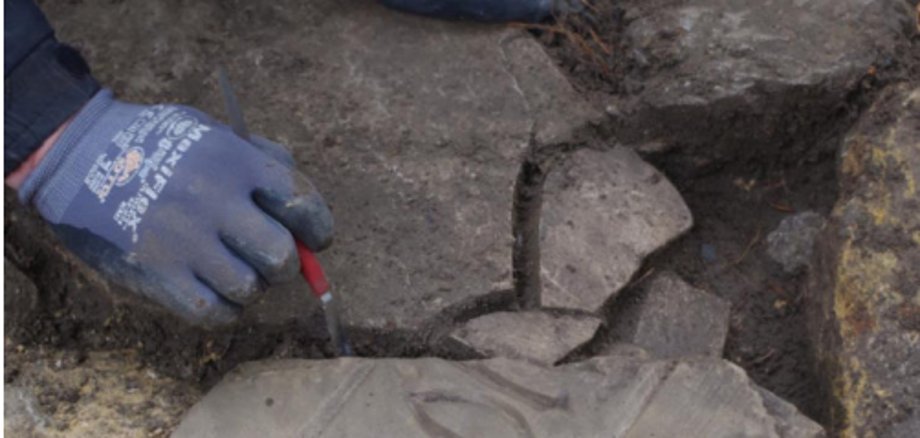Excavation work
Church square offers new insights into the city's history
"Numerous finds relating to the historical development of the urban area and the history of Beckum's urban society since the Middle Ages have been recovered," reports Dr Joachim Meffert from the Landschaftsverband Westfalen-Lippe (LWL), who led the excavations in collaboration with the Goldschmidt company.
We have documented over 200 burials of adults, adolescents and children in the 3,600 square metre area. Although burial objects are almost invariably missing from Christian burials, the finds are of archaeological and anthropological interest."

Wooden coffin remains, slab and stone box graves and the remains of so-called funeral wreaths were found. The funeral wreaths in particular, wreaths made of silver or bronze wire, which were apparently used to adorn unmarried girls, are a speciality from the early modern period. The skeletons are also informative for science: the scientists hope to gain insights into the diseases of the Beckum population in the Middle Ages. "Based on the remains, we can also determine whether unfavourable living conditions and malnutrition were responsible for the high mortality rate," continues Meffert. The oldest burials on the church square are slab and stone box graves from the 11th century, i.e. from the period before Beckum was founded.
Gravestone, bridal gate and pilgrim's horn
In addition to the numerous burials, the excavation team also discovered various interesting features, such as a large gravestone from the 15th century and a fragment of a so-called pilgrim's horn, which was probably originally made in the Aachen area. The Propsteigasse, formerly Kirchstraße, which was already paved in the Middle Ages, ended directly at the cemetery wall until the completion of the Gothic Propsteikirche church in 1517, which completely enclosed the area and kept out uninvited visitors such as stray dogs and wandering pigs. At that time, churchgoers entered the cemetery through a gate, the stone foundations of which remain in the ground to this day. The excavation team discovered further hidden traces of the medieval bridal gate (also known as the Marienpforte) in the ground on the north side of the church.
The name Brautpforte (bridal gate) refers to the medieval custom of marrying in front of the church portal before entering for mass:
When this practice changed in the 16th century and couples were allowed to marry in the church, the Beckum bridal portal also lost its function," explains the excavation manager.

However, it is still clearly recognisable in the Prussian original cadastral plans from 1806. After the churchyard at St Stephen's Church was abandoned around 1815, the entire area was converted into a green space and all the surrounding buildings were demolished.
Church had 3 predecessor buildings
There were also interesting findings on the south side of the church: at the end of the High Middle Ages, parts of the cemetery area were abandoned in order to extract sand for the construction of the new church. The material extraction pits were filled with building rubble at this time. "In total, today's church has three predecessor buildings from the Middle Ages," explains Meffert.
In general, the churchyard was only dug as deep as was necessary for the town's construction work. "If you think about how many generations are buried here from centuries of burials, it's quite impressive. The archaeological team will continue to supervise the construction work," says Meffert.
What happens to the bones?
As soon as all the work has been completed, the bones are transferred to the cemetery in Beckum and then blessed. "Exactly according to the same rite as was customary centuries ago," concludes the expert.
Special page church square conversion
Current construction work on St Stephen's church square:
- The redesign of the church square is part of the so-called "Integrated Action and Measures Concept for Beckum Town Centre" (IHMK for short). The IHMK forms the basis for action for the entire urban development of Beckum's city centre and is also an important prerequisite for applying for urban development funding.
- After the market square, the redesigned church square in the centre of the city will create another barrier-free recreation and relaxation area for the entire urban community with children's play equipment and 19 benches. New bicycle parking facilities will improve accessibility to the city centre by bicycle. In addition, Propsteigasse will in future be upgraded either as a traffic-calmed area or as a pedestrian zone.
- In the course of climate change, the frequency and intensity of heavy rainfall events will also increase in our region. Effective protection against the possible consequences of heavy rain begins with the urban planning concept. The city of Beckum is therefore also taking special precautions in the reconstruction of the Kirchplatz: by building new storage channels, a new sewer system in the area of the northern path, as well as terrain modelling and gutters, the adjacent properties will be better protected against heavy rainfall events in the future.
- The Münster district government has approved a grant of 897,182 euros from state and federal funds for the future-oriented and citizen-friendly redesign of the St. Stephanus church square. The parish is contributing 300,000 euros towards the costs.

